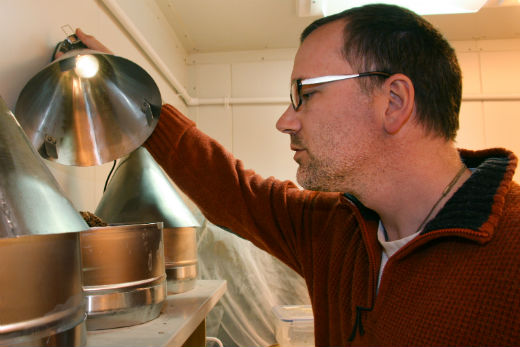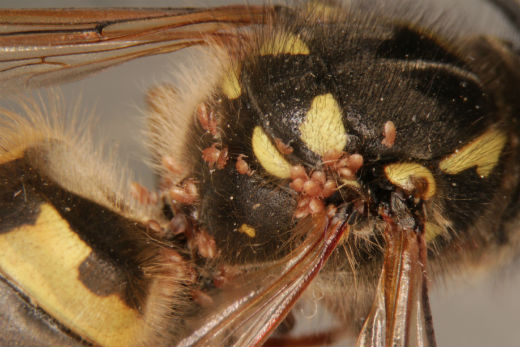A species of recently discovered mite that eats wasps is being checked to ensure it won't also eat bees.
The mite, discovered by Landcare Research scientist Dr Bob Brown on wasp nests in 2012, has recently been recognised as a new species and named - Pneumolaelaps niutirani by fellow Landcare Research scientist Dr Zhi-Qiang Zhang and Ministry for Primary Industries scientist Dr Qing-Hai Fan.
A wasp infested with tiny mites that look a promising biocontrol agent. Photo: Dr Bob Brown
Bob Brown has been researching the mites' potential as a biocontrol agent against wasps, which cost the country's primary industries around $130 million a year and cause biodiversity loses.
He has found wasp nests where the mites are present are at least half the size of uninfected nests. Immature mites have also been found in nests indicating wasps could be a host.
Other related species of mites are often found in association with bees. The next step is conducting safety trials to ensure the mite doesn't pose a risk to honeybees or bumblebees.

Landcare Research scientist Dr Bob Brown uses a funnel fitted with a halogen light to separate the mites from a wasp nest.
In order to do this, bee larvae will be fed stable isotopes and the mites later inspected to see if it is in their system, says Bob.
'Stable isotopes are molecules that act like a chemical marker that we can track. If the stable isotopes are found in the mites this will conclusively tell us they are feeding on the bees because there is no other way for them to acquire these molecules,” says Bob.
'We found the mites in low numbers in quite a few honeybee hives so we need to check out what their association is. It's not uncommon for organisms to have a different association with other species and feed on different things. It is possible the mites are there because they hitched a ride on wasps that were robbing honey from the hive.”
The tests will begin as soon as he's excavated wasp nests over the coming months and has access to the mites. Once complete, attention will turn to checking the mites are not harmful to native bees.
He will also investigate the associations between the mites and wasps. In particular, if and how the mites are responsible for decreased aggression levels in the wasps and how they are managing to enter the nests.
'Wasps don't like anything in their nest but somehow these mites are tricking them into letting them be there,” says Bob.
He wants to thank the public for the support after an appeal for wasp queens to assist his research saw him sent 436 from around the country. An analysis of the wasps found 35 per cent had a least one mite.

Landcare Research scientist Dr Bob Brown inspects a wasp for mites under the microscope.
The Vespula Biocontrol Action Group contracted Landcare Research to investigate the mite's potential as a biocontrol agent against wasps.
The research is funded by the Ministry of Primary Industries' Sustainable Farming Fund.
Landcare Research is a Crown research institute focused on environmental science. Developing biological controls for pests is a key part of its research. Biocontrol offers a cost-effective, environmentally friendly, and permanent solution.



3 comments
Oh dear
Posted on 07-02-2016 12:38 | By Cydifor
Every time a new creature is introduced to eliminate some pest, there is a problem. Go carefully!
Wasp bait
Posted on 07-02-2016 13:29 | By In Reality
Yes, Oh dear. I fully agree. Better still is a new product just released on the NZ market late last year. Vespex, something every bee keeper will love. Has to be applied by certified applicators , treatment is 8 days long, and will not harm other species, domestic animals or humans.
Swan Plants Wasps
Posted on 07-02-2016 13:51 | By carpedeum
Anyone any ideas around how to keep the wasps away from our Swan Plants. ?last year someone suggested blowing up a paper bag which fools them into thinking there is already a waspnest there ? does that really work ??
Leave a Comment
You must be logged in to make a comment.